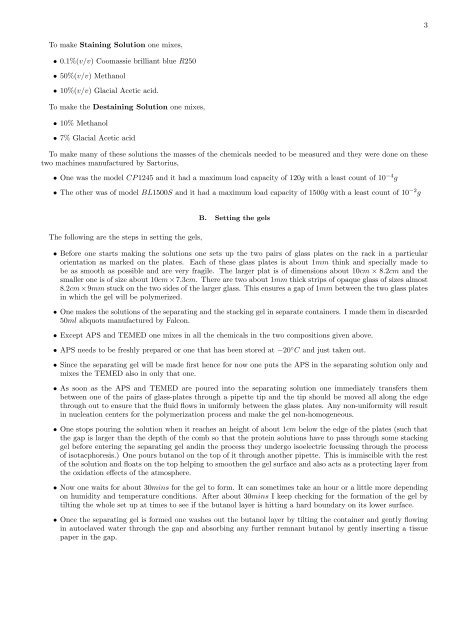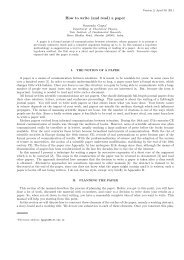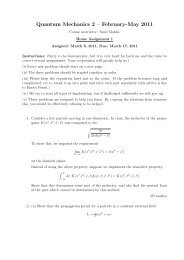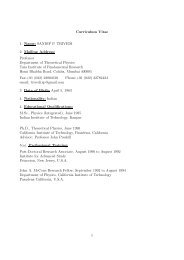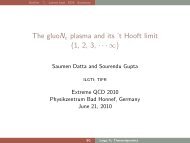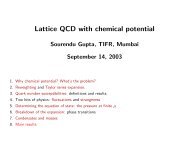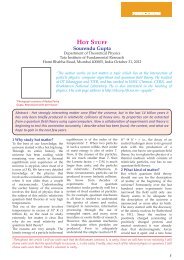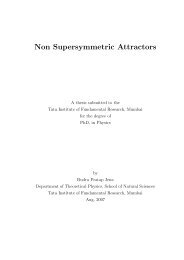A report on an experiment I did of doing electrophoresis with proteins
A report on an experiment I did of doing electrophoresis with proteins
A report on an experiment I did of doing electrophoresis with proteins
Create successful ePaper yourself
Turn your PDF publications into a flip-book with our unique Google optimized e-Paper software.
3<br />
To make Staining Soluti<strong>on</strong> <strong>on</strong>e mixes,<br />
• 0.1%(v/v) Coomassie brilli<strong>an</strong>t blue R250<br />
• 50%(v/v) Meth<strong>an</strong>ol<br />
• 10%(v/v) Glacial Acetic acid.<br />
To make the Destaining Soluti<strong>on</strong> <strong>on</strong>e mixes,<br />
• 10% Meth<strong>an</strong>ol<br />
• 7% Glacial Acetic acid<br />
To make m<strong>an</strong>y <strong>of</strong> these soluti<strong>on</strong>s the masses <strong>of</strong> the chemicals needed to be measured <strong>an</strong>d they were d<strong>on</strong>e <strong>on</strong> these<br />
two machines m<strong>an</strong>ufactured by Sartorius,<br />
• One was the model CP 1245 <strong>an</strong>d it had a maximum load capacity <strong>of</strong> 120g <strong>with</strong> a least count <strong>of</strong> 10 −4 g<br />
• The other was <strong>of</strong> model BL1500S <strong>an</strong>d it had a maximum load capacity <strong>of</strong> 1500g <strong>with</strong> a least count <strong>of</strong> 10 −2 g<br />
The following are the steps in setting the gels,<br />
B. Setting the gels<br />
• Before <strong>on</strong>e starts making the soluti<strong>on</strong>s <strong>on</strong>e sets up the two pairs <strong>of</strong> glass plates <strong>on</strong> the rack in a particular<br />
orientati<strong>on</strong> as marked <strong>on</strong> the plates. Each <strong>of</strong> these glass plates is about 1mm think <strong>an</strong>d specially made to<br />
be as smooth as possible <strong>an</strong>d are very fragile. The larger plat is <strong>of</strong> dimensi<strong>on</strong>s about 10cm × 8.2cm <strong>an</strong>d the<br />
smaller <strong>on</strong>e is <strong>of</strong> size about 10cm × 7.3cm. There are two about 1mm thick strips <strong>of</strong> opaque glass <strong>of</strong> sizes almost<br />
8.2cm × 9mm stuck <strong>on</strong> the two sides <strong>of</strong> the larger glass. This ensures a gap <strong>of</strong> 1mm between the two glass plates<br />
in which the gel will be polymerized.<br />
• One makes the soluti<strong>on</strong>s <strong>of</strong> the separating <strong>an</strong>d the stacking gel in separate c<strong>on</strong>tainers. I made them in discarded<br />
50ml aliquots m<strong>an</strong>ufactured by Falc<strong>on</strong>.<br />
• Except APS <strong>an</strong>d TEMED <strong>on</strong>e mixes in all the chemicals in the two compositi<strong>on</strong>s given above.<br />
• APS needs to be freshly prepared or <strong>on</strong>e that has been stored at −20 ◦ C <strong>an</strong>d just taken out.<br />
• Since the separating gel will be made first hence for now <strong>on</strong>e puts the APS in the separating soluti<strong>on</strong> <strong>on</strong>ly <strong>an</strong>d<br />
mixes the TEMED also in <strong>on</strong>ly that <strong>on</strong>e.<br />
• As so<strong>on</strong> as the APS <strong>an</strong>d TEMED are poured into the separating soluti<strong>on</strong> <strong>on</strong>e immediately tr<strong>an</strong>sfers them<br />
between <strong>on</strong>e <strong>of</strong> the pairs <strong>of</strong> glass-plates through a pipette tip <strong>an</strong>d the tip should be moved all al<strong>on</strong>g the edge<br />
through out to ensure that the fluid flows in uniformly between the glass plates. Any n<strong>on</strong>-uniformity will result<br />
in nucleati<strong>on</strong> centers for the polymerizati<strong>on</strong> process <strong>an</strong>d make the gel n<strong>on</strong>-homogeneous.<br />
• One stops pouring the soluti<strong>on</strong> when it reaches <strong>an</strong> height <strong>of</strong> about 1cm below the edge <strong>of</strong> the plates (such that<br />
the gap is larger th<strong>an</strong> the depth <strong>of</strong> the comb so that the protein soluti<strong>on</strong>s have to pass through some stacking<br />
gel before entering the separating gel <strong>an</strong>din the process they undergo isoelectric focussing through the process<br />
<strong>of</strong> isotacphoresis.) One pours but<strong>an</strong>ol <strong>on</strong> the top <strong>of</strong> it through <strong>an</strong>other pipette. This is immiscible <strong>with</strong> the rest<br />
<strong>of</strong> the soluti<strong>on</strong> <strong>an</strong>d floats <strong>on</strong> the top helping to smoothen the gel surface <strong>an</strong>d also acts as a protecting layer from<br />
the oxidati<strong>on</strong> effects <strong>of</strong> the atmosphere.<br />
• Now <strong>on</strong>e waits for about 30mins for the gel to form. It c<strong>an</strong> sometimes take <strong>an</strong> hour or a little more depending<br />
<strong>on</strong> humidity <strong>an</strong>d temperature c<strong>on</strong>diti<strong>on</strong>s. After about 30mins I keep checking for the formati<strong>on</strong> <strong>of</strong> the gel by<br />
tilting the whole set up at times to see if the but<strong>an</strong>ol layer is hitting a hard boundary <strong>on</strong> its lower surface.<br />
• Once the separating gel is formed <strong>on</strong>e washes out the but<strong>an</strong>ol layer by tilting the c<strong>on</strong>tainer <strong>an</strong>d gently flowing<br />
in autoclaved water through the gap <strong>an</strong>d absorbing <strong>an</strong>y further remn<strong>an</strong>t but<strong>an</strong>ol by gently inserting a tissue<br />
paper in the gap.


